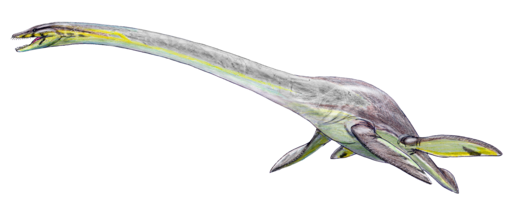The Long-Necked Marine Reptile
Elasmosaurus was a giant marine reptile that lived during the Late Cretaceous period, approximately 80 million years ago.


| Meaning | Thin plate lizard [Elasmo-saurus] |
| Pronunciation | ee-LAZ-moh-sore-us |
| When: | Late Cretaceous (about 80–65 million years ago) |
| Where: | North America (USA, Kansas) |
| What: | Plesiosaur (marine reptile) |
| Weight: | Estimated around 2–3 metric tons |
| Length: | Approximately 10–14 meters (33–46 feet) |
| Diet: | Piscivorous (ate fish and small marine organisms) |
| Discovered: | First described by Edward Drinker Cope in 1868 |
It belonged to a group of marine reptiles known as plesiosaurs, characterized by their long necks, streamlined bodies, and paddle-like limbs adapted for swimming.
Elasmosaurus was one of the largest plesiosaurs, measuring up to 14 meters (46 feet) in length.
One of the most striking features of Elasmosaurus was its extremely long neck, which consisted of over 70 vertebrae—more than any other known vertebrate.
This neck allowed Elasmosaurus to hunt for fish and other marine prey while keeping its body relatively submerged underwater.
Despite its size, Elasmosaurus was a swift and agile swimmer, using its powerful flippers to navigate the ancient seas.
Fossils of Elasmosaurus have been found in North America, particularly in Kansas and Wyoming, where the first specimens were discovered in the 19th century.
